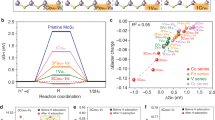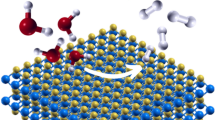Abstract
Develo** alternative oxygen reduction reaction (ORR) catalysts to replace precious Pt-based metals with abundant materials is the key challenge of commercial application of fuel cells. Owing to their various compositions and tunable electronic properties, transition metal dichalcogenides (TMDs) have the great potential to realize high-efficiency catalysts for ORR. Here, various 3R-phase dichalcogenides of group VB and VIB transition metals (MX2, M = Nb, Ta, Mo, W; X = S, Se, Te) are investigated for ORR catalysts by using density functional theory calculations. The computed over-potentials of group VB TMDs are much less than those of group VIB TMDs. For group VB TMDs, a volcano-type plot of ORR catalytic activity is established on the adsorption energies of *OH, and NbS2 and TaTe2 exhibit best ORR activity with an over-potential of 0.54 V. To achieve even better activity, strain engineering is performed to tune ORR catalytic activity, and the minimum over-potential of 0.43 V can be realized. We further demonstrate that the shift of p orbital center of surface chalcogen elements under strain is responsible for tuning the catalytic activity of TMDs.

Similar content being viewed by others
References
Debe, M. K. Electrocatalyst approaches and challenges for automotive fuel cells. Nature 2012, 486, 43–51.
Wu, J. B.; Yang, H. Platinum–based oxygen reduction electrocatalysts. Acc. Chem. Res. 2013, 46, 1848–1857.
Stamenkovic, V. R.; Fowler, B.; Mun, B. S.; Wang, G. F.; Ross, P. N.; Lucas, C. A.; Marković, N. M. Improved oxygen reduction activity on Pt3Ni(111) via increased surface site availability. Science 2007, 315, 493–497.
Zou, L. L.; Fan, J.; Zhou, Y.; Wang, C. M.; Li, J.; Zou, Z. Q.; Yang, H. Conversion of PtNi alloy from disordered to ordered for enhanced activity and durability in methanol–tolerant oxygen reduction reactions. Nano Res. 2015, 8, 2777–2788.
Zheng, F. L.; Wong, W. T.; Yung, K. F. Facile design of Au@Pt core–shell nanostructures: Formation of Pt submonolayers with tunable coverage and their applications in electrocatalysis. Nano Res. 2014, 7, 410–417.
Viswanathan, V.; Hansen, H. A.; Rossmeisl, J.; Nørskov, J. K. Universality in oxygen reduction electrocatalysis on metal surfaces. ACS Catal. 2012, 2, 1654–1660.
Greeley, J.; Stephens, I. E. L.; Bondarenko, A. S.; Johansson, T. P.; Hansen, H. A.; Jaramillo, T. F.; Rossmeisl, J.; Chorkendorff, I.; Nørskov, J. K. Alloys of platinum and early transition metals as oxygen reduction electrocatalysts. Nat. Chem. 2009, 1, 552–556.
Bai, S.; Wang, C. M.; Jiang, W. Y.; Du, N. N.; Li, J.; Du, J. T.; Long, R.; Li, Z. Q.; **ong, Y. J. Etching approach to hybrid structures of PtPd nanocages and graphene for efficient oxygen reduction reaction catalysts. Nano Res. 2015, 8, 2789–2799.
De Bruijn, F. A.; Dam, V. A. T.; Janssen, G. J. M. Review: Durability and degradation issues of PEM fuel cell components. Fuel Cells 2008, 8, 3–22.
Jiao, Y.; Zheng, Y.; Jaroniec, M.; Qiao, S. Z. Design of electrocatalysts for oxygen–and hydrogen–involving energy conversion reactions. Chem. Soc. Rev. 2015, 44, 2060–2086.
Guo, D. H.; Shibuya, R.; Akiba, C.; Saji, S.; Kondo, T.; Nakamura, J. Active sites of nitrogen–doped carbon materials for oxygen reduction reaction clarified using model catalysts. Science 2016, 351, 361–365.
Zhang, J. T.; Zhao, Z. H.; **a, Z. H.; Dai, L. M. A metal–free bifunctional electrocatalyst for oxygen reduction and oxygen evolution reactions. Nat. Nanotechnol. 2015, 10, 444–452.
Zou, X. L.; Wang, L. Q.; Yakobson, B. I. Mechanisms of the oxygen reduction reaction on B–and/or N–doped carbon nanomaterials with curvature and edge effects. Nanoscale 2018, 10, 1129–1134.
Yan, D. F.; Guo, L.; **e, C.; Wang, Y. Y.; Li, Y. X.; Li, H.; Wang, S. Y. N, P–dual doped carbon with trace Co and rich edge sites as highly efficient electrocatalyst for oxygen reduction reaction. Sci. China Mater. 2018, 61, 679–685.
Ma, R. G.; Ren, X. D.; **a, B. Y.; Zhou, Y.; Sun, C.; Liu, Q.; Liu, J. J.; Wang, J. C. Novel synthesis of N–doped graphene as an efficient electrocatalyst towards oxygen reduction. Nano Res. 2016, 9, 808–819.
Shen, M. X.; Wei, C. T.; Ai, K. L.; Lu, L. H. Transition metal–nitrogen–carbon nanostructured catalysts for the oxygen reduction reaction: From mechanistic insights to structural optimization. Nano Res. 2017, 10, 1449–1470.
Wang, J.; Huang, Z. Q.; Liu, W.; Chang, C. R.; Tang, H. L.; Li, Z. J.; Chen, W. X.; Jia, C. J.; Yao, T.; Wei, S. Q. et al. Design of N–coordinated dualmetal sites: A stable and active Pt–free catalyst for acidic oxygen reduction reaction. J. Am. Chem. Soc. 2017, 139, 17281–17284.
Zitolo, A.; Goellner, V.; Armel, V.; Sougrati, M. T.; Mineva, T.; Stievano, L.; Fonda, E.; Jaouen, F. Identification of catalytic sites for oxygen reduction in iron–and nitrogen–doped graphene materials. Nat. Mater. 2015, 14, 937–942.
Song, K.; Long, Y.; Wang, X.; Zhou, G. Theoretical investigations of transport properties of organic solvents in cation–functionalized graphene oxide membranes: Implications for drug delivery. Nano Res. 2018, 11, 254–263.
Wu, G.; More, K. L.; Johnston, C. M.; Zelenay, P. High–performance electrocatalysts for oxygen reduction derived from polyaniline, iron, and cobalt. Science 2011, 332, 443–447.
Shang, C. Q.; Yang, M. Y.; Wang, Z. Y.; Li, M. C.; Liu, M.; Zhu, J.; Zhu, Y. G.; Zhou, L. J.; Cheng, H.; Gu, Y. Y. et al. Encapsulated MnO in N–do** carbon nanofibers as efficient ORR electrocatalysts. Sci. China Mater. 2017, 60, 937–946.
Liao, W. X.; Zhou G. Conditions for magnetic and electronic properties of ultrathin Ni–Fe hydroxide nanosheets as catalysts: A DFT+U study. Sci. China Mater. 2017, 60, 664–673.
Chen, Z. W.; Higgins, D.; Yu, A. P.; Zhang, L.; Zhang, J. J. A review on non–precious metal electrocatalysts for PEM fuel cells. Energy Environ. Sci. 2011, 4, 3167–3192.
Eng, A. Y. S.; Ambrosi, A.; Sofer, Z.; Šimek, P.; Pumera, M. Electrochemistry of transition metal dichalcogenides: Strong dependence on the metalto–chalcogen composition and exfoliation method. ACS Nano 2014, 8, 12185–12198.
Huang, H.; Feng, X.; Du, C. C.; Song, W. B. High–quality phosphorusdoped MoS2 ultrathin nanosheets with amenable ORR catalytic activity. Chem. Commun. 2015, 51, 7903–7906.
Huang, H.; Feng, X.; Du, C.; Wu, S.; Song, W. Incorporated oxygen in MoS2 ultrathin nanosheets for efficient ORR catalysis. J. Mater. Chem. A 2015, 3, 16050–16056.
Zhang, H. Y.; Tian, Y.; Zhao, J. X.; Cai, Q. H.; Chen, Z. F. Small dopants make big differences: Enhanced electrocatalytic performance of MoS2 monolayer for oxygen reduction reaction (ORR) by N–and P–do**. Electrochim. Acta 2017, 225, 543–550.
Wang, Z. X.; Zhao, J. X.; Cai, Q. H.; Li, F. Y. Computational screening for high–activity MoS2 monolayer–based catalysts for the oxygen reduction reaction via substitutional do** with transition metal. J. Mater. Chem. A 2017, 5, 9842–9851.
Bu, L. Z.; Zhang, N.; Guo, S. J.; Zhang, X.; Li, J.; Yao, J. L.; Wu, T.; Lu, G.; Ma, J. Y.; Su, D. et al. Biaxially strained PtPb/Pt core/shell nanoplate boosts oxygen reduction catalysis. Science 2016, 354, 1410–1414.
Ling, T.; Yan, D. Y.; Wang, H.; Jiao, Y.; Hu, Z. P.; Zheng, Y.; Zheng, L. R.; Mao, J.; Liu, H.; Du, X. W. et al. Activating cobalt(II) oxide nanorods for efficient electrocatalysis by strain engineering. Nat. Commun. 2017, 8, 1509.
Noh, S. H.; Han, B.; Ohsaka, T. First–principles computational study of highly stable and active ternary PtCuNi nanocatalyst for oxygen reduction reaction. Nano Res. 2015, 8, 3394–3403.
Strasser, P.; Koh, S.; Anniyev, T.; Greeley, J.; More, K.; Yu, C. F.; Liu, Z. C.; Kaya, S.; Nordlund, D.; Ogasawara, H. et al. Lattice–strain control of the activity in dealloyed core–shell fuel cell catalysts. Nat. Chem. 2010, 2, 454–460.
Voiry, D.; Yamaguchi, H.; Li, J. W.; Silva, R.; Alves, D. C. B.; Fujita, T.; Chen, M. W.; Asefa, T.; Shenoy, V. B.; Eda, G. et al. Enhanced catalytic activity in strained chemically exfoliated WS2 nanosheets for hydrogen evolution. Nat. Mater. 2013, 12, 850–855.
Luxa, J.; Mazánek, V.; Pumera, M.; Lazar, P.; Sedmidubský, D.; Callisti, M.; Polcar, T.; Sofer, Z. 2H→1T Phase Engineering of layered tantalum disulfides in electrocatalysis: Oxygen reduction reaction. Chem.–Eur. J. 2017, 23, 8082–8091.
Chhowalla, M.; Shin, H. S.; Eda, G.; Li, L. J.; Loh, K. P.; Zhang, H. The chemistry of two–dimensional layered transition metal dichalcogenide nanosheets. Nat. Chem. 2013, 5, 263–275.
Toh, R. J.; Sofer, Z.; Luxa, J.; Sedmidubský, D.; Pumera, M. 3R phase of MoS2 and WS2 outperforms the corresponding 2H phase for hydrogen evolution. Chem. Commun. 2017, 53, 3054–3057.
Feng, Y.; Gong, S. J.; Du, E. W.; Chen, X. F.; Qi, R. J.; Yu, K.; Zhu, Z. Q. 3R TaS2 surpasses the corresponding 1T and 2H phases for the hydrogen evolution reaction. J. Phys. Chem. C 2018, 122, 2382–2390.
Kresse, G.; Furthmüller, J. Efficiency of ab–initio total energy calculations for metals and semiconductors using a plane–wave basis set. Comput. Mater. Sci. 1996, 6, 15–50.
Kresse, G.; Joubert, D. From ultrasoft pseudopotentials to the projector augmented–wave method. Phys. Rev. B 1999, 59, 1758–1775.
Perdew, J. P.; Burke, K.; Ernzerhof, M. Generalized gradient approximation made simple. Phys. Rev. Lett. 1996, 77, 3865.
Grimme, S. Semiempirical GGA–type density functional constructed with a long–range dispersion correction. J. Comput. Chem. 2006, 27, 1787–1799.
Nørskov, J. K.; Rossmeisl, J.; Logadottir, A.; Lindqvist, L.; Kitchin, J. R.; Bligaard, T.; Jónsson, H. Origin of the overpotential for oxygen reduction at a fuel–cell cathode. J. Phys. Chem. B 2004, 108, 17886–17892.
Choi, C. H.; Lim, H. K.; Chung, M. W.; Park, J. C.; Shin, H.; Kim, H.; Woo, S. I. Long–range electron transfer over graphene–based catalyst for high–performing oxygen reduction reactions: Importance of size, N–do**, and metallic impurities. J. Am. Chem. Soc. 2014, 136, 9070–9077.
Bligaard, T.; Nørskov, J. K.; Dahl, S.; Matthiesen, J.; Christensen, C. H.; Sehested, J. The Brønsted–Evans–Polanyi relation and the volcano curve in heterogeneous catalysis. J. Catal. 2004, 224, 206–217.
Che, M. Nobel Prize in chemistry 1912 to Sabatier: Organic chemistry or catalysis. Catal. Today 2013, 218–219, 162–171.
Vojvodic, A.; Hellman, A.; Ruberto, C.; Lundqvist, B. I. From electronic structure to catalytic activity: A single descriptor for adsorption and reactivity on transition–metal carbides. Phys. Rev. Lett. 2009, 103, 146103.
Bonde, J.; Moses, P. G.; Jaramillo, T. F.; Nørskov, J. K.; Chorkendorff, I. Hydrogen evolution on nano–particulate transition metal sulfides. Faraday Discuss. 2009, 140, 219–231.
Acknowledgements
This work was supported by the National Key Research and Development Program of China (No. 2017YFB0701600), the National Natural Science Foundation of China (Nos. 11874036, 51622103, and 21573123), the Local Innovative and Research Teams Project of Guangdong Pearl River Talents Program (No. 2017BT01N111), Shenzhen Projects for Basic Research (No. JCYJ20170412171430026), and the National Program for Thousand Young Talents of China. Tian** Supercomputing Center is also acknowledged for allowing the use of computational resources including TIANHE-1.
Author information
Authors and Affiliations
Corresponding authors
Electronic supplementary material
12274_2019_2326_MOESM1_ESM.pdf
Group VB transition metal dichalcogenides for oxygen reduction reaction and strain-enhanced activity governed by p-orbital electrons of chalcogen
Rights and permissions
About this article
Cite this article
Zhao, S., Wang, K., Zou, X. et al. Group VB transition metal dichalcogenides for oxygen reduction reaction and strain-enhanced activity governed by p-orbital electrons of chalcogen. Nano Res. 12, 925–930 (2019). https://doi.org/10.1007/s12274-019-2326-7
Received:
Revised:
Accepted:
Published:
Issue Date:
DOI: https://doi.org/10.1007/s12274-019-2326-7




